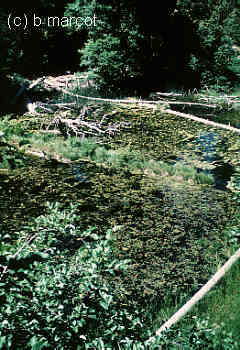
In several stable ponds I discovered some water plants rather rare to California, such as the entirely submergent and rather dwarfish Scirpus subterminalis, the sedge-like Dulichium arundinaceum growing on a floating bog mat, and the sundew Drosera rotundifolia growing on the edges of floating logs that still had bark intact but did not have lush cover of other plants such as willows and alders.
For wildlife, stable ponds affort year-round cover, water sources, and feeding opportunities, particularly in the parched Mediterranean summers of inland northwest California. I found many populations of newts, frogs, pond turtles, and associations of many riparian and aquatic birds and mammals with stable ponds. As a wildlife haven, they are remarkable.
Here is a stable pond in northwestern California, showing many of the features discussed above:

I named this pond "Primal Pond" because, with its dragonflies and emerging mayflies, it seemed to literally breath with a primal soup of life. In fact, I discovered and named several dozen ponds on Six Rivers National Forest, and created a map and aerial photo atlas of their locations to facilitate their conservation as wildlife habitat.
Stable ponds are valuable tools for exploring the trophic health of the surrounding subbasin. By annotating the periplankton, phytoplankton, and algae present in the pond, one can index the degree of eutrophication and the recency of siltation. Ponds, therefore, can be vital indicators to how well our forest 'ecosystem management' activities really serve to maintain the health of subbasins.
The management lesson for stable ponds usually is, leave them alone! They seldom need "management" or "enhancement." The most one could do is to pile slash along the shoreline as cover for reptiles, or fall a couple trees into the ponds as basking sites for pond turtles and frogs. But on their own, stable ponds are indeed "primal" and need little enhancement.